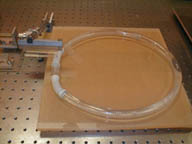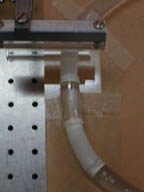| |
The Valveless Pump
Project
|
|
| |
Numerical
simulations by E. Jung and C. Peskin have demonstrated that a
closed circuit of fluid can produce a directional flow under
periodic forcing. The intriguing aspect of the phenomenon is the
absence of valves in the system. The simulations show that the flow
speed and direction depends upon the frequency and amplitude of
excitation. Inspired by their studies, we performed a tabletop
experiment studying the 3D valveless pump. We have observed the
flow reversal at certain pumping frequencies and amplitudes. By
this summer, we will be able to address the phenomenon more
quantitatively, using flow visualization and LDV measurements to
study the phenomenon. |
|
| |
 |
A simple model of a valveless pump: It consists
of three parts, a hard (transparent) tube and two soft,
elastic (and translucent) tube segments. When a periodic
force is applied to one of the soft segments, a directional flow is
induced in the circuit. |
|
|
| |
| A closeup of the pumping mechanism: At
the upper-left corner, a mechanical "finger" is driven periodically
against the soft tubing . Its amplitude and frequency can be
adjusted continuously. |
 |
|
|
| |
|
|
|
Back
|

